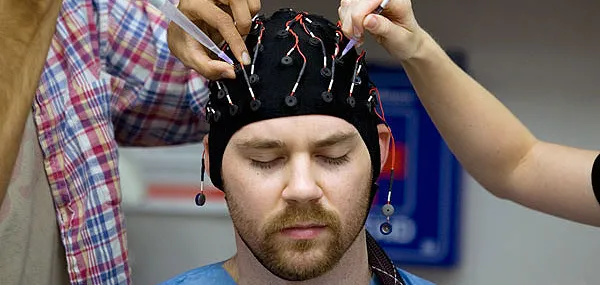
Stanford Report - April 15th, 2009 - by Sara Wykes
For the millions of people who suffer from epilepsy, what is going on in Jeff Nelson's brain might be a map to freedom.
Twice now, Nelson has come to Stanford Hospital & Clinics to undergo long hours of testing. First, he sits patiently while neuroscientists attach electrical cables to a special hat he wears during testing. It takes some time—the cables are as plentiful as blades of grass sprouting from a well-sown lawn. Then, into the narrow tunnel of the MRI he goes. The wires gauge his brain's electrical pulses, sending the data as an electroencephalogram, an EEG. The MRI will operate in a special advanced mode called fMRI, short for functional magnetic resonance imaging, to record changes in blood flow in Nelson's brain. Those changes mark the location of the unusual brain activity epilepsy produces.
In effect, Stanford Physicians have transformed a previously silent seizure film into a talking motion picture.
Stanford is one of just a few places in the world where physicians and scientists have succeeded in overcoming the practical hurdles of correlating information from the EEG and the fMRI, said Josef Parvizi, MD, PhD, a neurology specialist with the Stanford Comprehensive Epilepsy Clinic who leads the team of investigators studying Nelson's brain.
The combination of the two forms of seizure observation allows Stanford physicians to see something previously very elusive: the real time interaction between the brain's architecture and the electrical abnormalities that spark epileptic seizures. In effect, they have transformed a previously silent seizure film into a talking motion picture.
More than 2 million people in the United States have epilepsy, but Nelson is here because he has a special form of epilepsy that affects one in 10 people with the disease. Instead of being random, unpredictable occurrences, his reflex epilepsy involves seizures that happen after exposure to a certain sight, smell, or sound. They are set off most often by simplistic images of the human body, particularly the big round eyes in many cartoon characters or even stick figure drawings.
These and other reliable and known triggers enable Nelson's physicians at Stanford to produce and then observe a seizure, capturing valuable data. The analysis of what goes on in Nelson's brain during a seizure is building a behavioral diagram that may one day guide a less invasive, less risky and more permanent treatment for epilepsy.
"Seizures do not affect single centers in the brain," Parvizi said. "Instead, the excess electrical activity that produces a seizure travels on a network whose pathways range over several areas of the brain. Being able to interrupt, very specifically, the seizure network's connections and pathways, is the treatment goal—and an alternative to brain surgery."
"Saying seizures start in one place is a simplification because our trillions of brain cells are interconnected," said Robert Fisher, MD, director of the epilepsy center. "The work Dr. Parvizi is doing by combining state-of-the-art electrical and imaging methods will take our understanding of seizure origin and behavioral consequences into the next dimension. Within a few years, this work may allow us to disrupt the spread and mitigate the effects of seizures."
Nelson sees the test as a way to speed the day when he and others whose lives are altered by epilepsy will no longer need to shape their lives around it. His seizures began in childhood and, now, even with medication, he may have up to 20 seizures in one day.
Nelson's illness had not emerged as a problem while he pursued an undergraduate degree in art history from University of California-Santa Cruz. Upon graduating, he had been on course to begin a master's degree in ancient Chinese history, but then the epilepsy made that impossible. So he turned to chronicling, with an artist's eye, the hallucinations he sees while in seizure.
He lives in a small town in the Central Valley of California, where he can get around by bike. He had wanted to be a teacher, but he cannot trust that he will not have a seizure in front of a classroom of students. If he meets someone for the first time, he may not make direct eye contact. Sometimes, that kind of look can trigger a seizure.
Each seizure is unique and comes with its own emotional overlay and visual expression. A seizure "can start as a bright light flashing in the center of my vision," he said. "From there, things start to swirl around, a lot of swirling colors, like a galaxy."
Sometimes, a bright white light suffuses whatever is before him. Then the objects fracture until everything jumbles up like a do-it-yourself kaleidoscope. Once, he said, "I honestly could describe what I saw as angels. I felt like I was almost lifted out of my body. There were three angelic figures. They were just hovering. Normally in a seizure, I get an unpleasant feeling, a fear. This time I had a joyous feeling. I didn't want it to stop."
In other seizures, things go black and he sees a ball with colors emanating off it. "This ball feels like it's moving through my brain," he said. "I almost have this sense that it's grinding my brain."
At first, Nelson painted only what he saw in his seizures. "I call this my therapy period," he said, "because what I was doing was getting out a whole lot of this stuff that was inside my head." He now paints other things. The joy it brings offers some relief from the frustration of a disease that limits his ability to be with people. "It's socially crippling," he said. "People who know me are aware of my seizures and are okay with it. It probably bothers me more than it bothers them. When it comes to making new friends, I've got a lot at stake. Do I tell somebody right off the bat or do I wait?"
He is eager to see what his tests reveal, to see if enough new information might be visible to outline a new treatment for him. "But I consider myself blessed," he said. "Many people have it a million times worse than I do."

